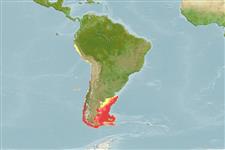Common names from other countries
Environment: milieu / climate zone / depth range / distribution range
Ecologia
Demersal; intervalo de profundidade 0 - 350 m (Ref. 275), usually 150 - 250 m (Ref. 106901). Subtropical, preferred 10°C (Ref. 107945); 3°S - 57°S, 81°W - 55°W (Ref. 275)
Southeast Pacific and Southwest Atlantic.
Length at first maturity / Tamanho / Peso / Idade
Maturity: Lm ? range ? - ? cm Max length : 28.0 cm ML macho/indeterminado; (Ref. 104650)
Inhabits the continental shelf (Ref. 106838). Found near the bottom. Undergoes horizontal ontogenetic migrations wherein juveniles move from spawning grounds in shallow, inshore waters at depths of 20 to 50 m, to offshore feeding grounds near the shelf edge at depths of 200 to 350 m. It then migrates back to inshore waters to spawn (Ref. 106901).
Life cycle and mating behavior
Maturidade | Reprodução | Desova | Ovos | Fecundidade | Larvas
Members of the class Cephalopoda are gonochoric. Male and female adults usually die shortly after spawning and brooding, respectively. Mating behavior: Males perform various displays to attract potential females for copulation. During copulation, male grasp the female and inserts the hectocotylus into the female's mantle cavity where fertilization usually occurs. Life cycle: Embryos hatch into planktonic stage and live for some time before they grow larger and take up a benthic existence as adults.
Roper, C.F.E., M.J. Sweeney and C.E. Nauen. 1984. (Ref. 275)
Categoria na Lista Vermelha da IUCN (Ref. 130435)
Categoria CITES (Ref. 108899)
Not Evaluated
Not Evaluated
Utilização humana
Pescarias: espécies comerciais
FAO - pescarias: landings, perfil da espécie | FishSource | Sea Around Us
Ferramentas
Fontes da internet
Estimates based on models
Preferred temperature
(Ref.
115969): 4.4 - 12.7, mean 6 (based on 72 cells).
Resiliência
Elevada, tempo mínimo de duplicação da população menor que 15 meses (K=0.07-0.9).
Prior r = 0.48, 95% CL = 0.32 - 0.72, Based on 1 data-limited stock assessment.
Vulnerabilidade
Low vulnerability (20 of 100).
